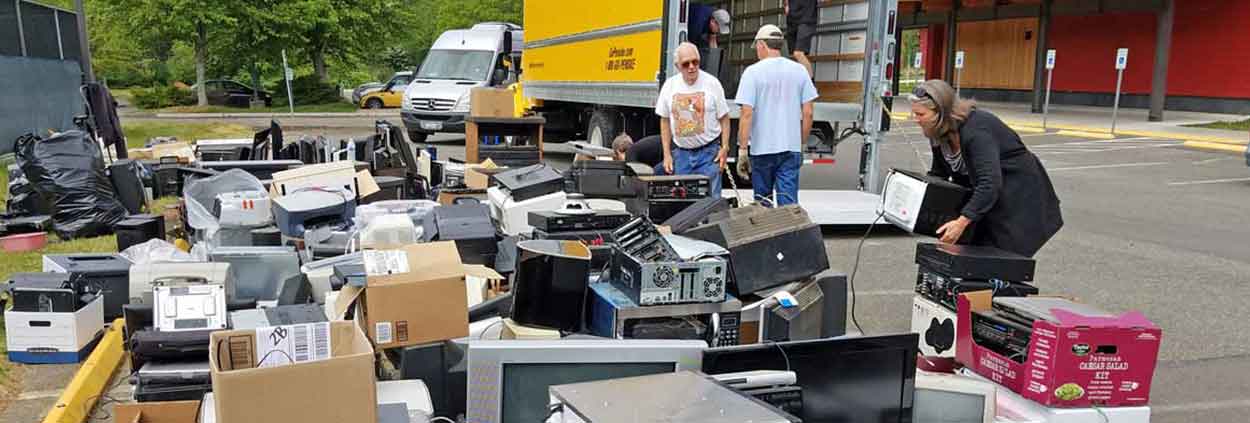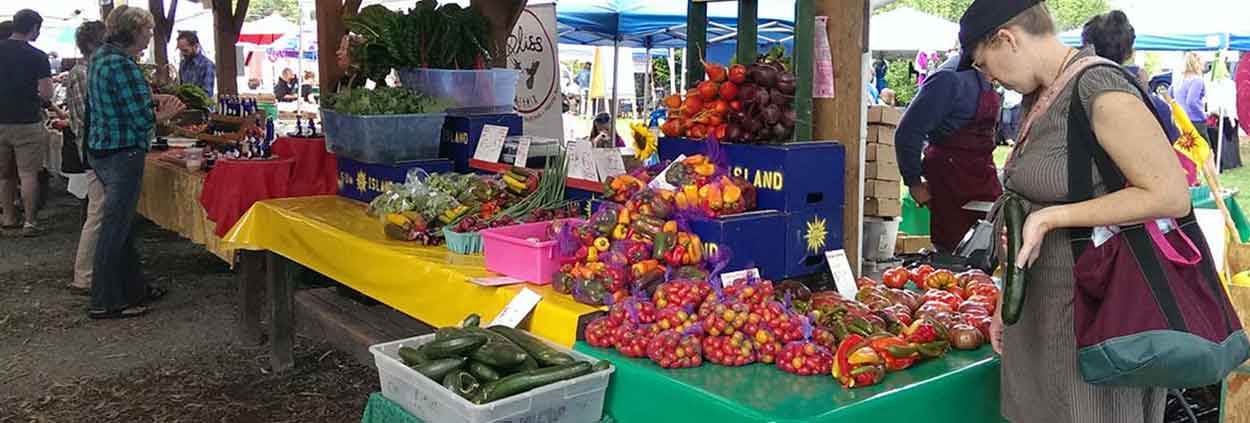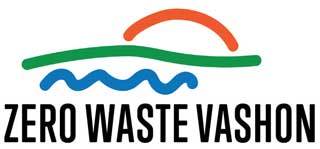Basic recycling to biochar
Solutions
Recycling electronics keeps heavy metals and plastics out of the landfills. Look for ZWV’s E-Cycling events, held every year.

Biochar is a stable solid, rich in carbon and can endure in soil for thousands of years.

Buying vegetables at Farmers Markets reduces need for packaging. Plus, it’s fresher!

Current technologies exist to significantly reduce the waste stream going to landfills. ZWV is investigating processes to reduce organic waste via composting, anaerobic digestion and bio-char production. These combined technologies could result in nearly a 50% reduction in waste currently trucked off-Island to the landfill at Cedar Hills.
The most familiar technology is also the oldest: composting which uses air breathing bacteria to break down compostable materials into a great soil amendment. A more modern version is Anaerobic Digestion which uses bacteria in the absence of oxygen to breakdown the organic material. A third technology is both ancient and new, biochar. BioChar is the charcoal created in the absence of oxygen. It has special properties that make it a wonderful soil synergistic amendment. We’ll cover these technologies in detail in the following pages. But the first step is easier. It begins in the home. We can all reduce waste by avoiding excess packaging, bulk purchasing, and active recycling.
For more on current solutions as well as evolving technologies, see below:
Yard and Food Waste Program
The Vashon Transfer Station accepts food and yard waste separate from general trash. The fee is $12 for the first 320 pounds. Consider getting together with neighbors and consolidating your food waste on a weekly basis if you don’t have a home composting system. This is a great option for apartment and condos. Currently food waste collection is also happening once a week at the Episcopal and Presbyterian churches and in the Gold Beach neighborhood.
Of compostable materials delivered to the collection site, yard waste outweighs food waste by far. While people are happy to participate if it’s convenient, we understand how hauling small lots of food waste to VRTS may feel inconvenient and pricey. ZWV has been partnering with multiple island churches to collect weekly batches of food waste from island households. We are researching creative ways to gather and transport this resource. If you’ve got a good idea about centralized collection, please let us know.
This spring, KCSWD will do a waste characterization study at VRTS. This study will contribute to our overall understanding of the feedstock potentially available for future reuse and help us to determine best technologies. Stay tuned…
Aerobic Composting
In aerobic composting, oxygen is used to accelerate the decay of organic material into compost. When free of contaminants, it is an excellent soil fertilizer as it increases its humus content. The process involves collection of feedstock, grinding of large woody material into smaller chips, and processing on concrete pads that trap any water runoff. Microbes break down the organic material. They thrive in an environment of 55% moisture, a 30:1 carbon to nitrogen ratio and with good airflow. The incoming feedstock is blended to create the ideal C to N ratio. The compost piles are monitored for temperature, moisture, oxygen and porosity to maintain optimum conditions. The compost will cook at 140-170°F for a pathogen reduction phase during which it is turned to aerate and ensure even heating. This is known as the pathogen reduction phase. It helps kill weed seeds and destroys fertilizers found in lawn grass. After this phase the compost goes through aeration and curing phases. The final product is screened before being ready for market. Aerobic composting can be done in either an open or closed system.
Closed or in-vessel composting is done in a closed environment. This can be a rotary drum or a large stainless steel lined container. The advantages of in-vessel composting are tighter control of temperature, odors, rodent control and the ability to compost meat and dairy products. Typically closed composters create compost quicker than open static piles.
Composting Benefits:
- large reduction of waste stream going off island
- organics, soil, and water remain on island
- most organic and paper waste is compostable
- compost is an excellent soil amendment
- it is a fairly low tech process
- reduced groundwater contamination by farm manure piles
- reduced Puget Sound water contamination by clean green groundwater piles
Risks:
- contamination by persistent pesticides
- vermin and odor control if waste food or manures are added
- physical ailments from unprotected contact
Anaerobic Digestion
Anaerobic digestion is a biological process that occurs when organic matter (in liquid or slurry form) is decomposed by bacteria in the absence of oxygen (i.e., anaerobic). As the bacteria “work,” biogas is released, which consists of approximately 60-70% methane and 30-40% carbon dioxide. This methane gas can be recovered, treated and used to generate energy in place of traditional fossil fuels while reducing greenhouse gas emissions. The effluent remaining after controlled anaerobic decomposition is low in odor and rich in nutrients. Anaerobic digestion systems are often referred to as “anaerobic digesters,” “biodigesters” or “biogas recovery systems.” AD systems are usually preferred for municipal systems because they are closed systems that control odor, seepage, and work much faster than aerobic systems.
Digester effluent can be separated into liquids and solids that add economic value to a project. The liquid effluent from a digester can be used as a fertilizer, reducing the purchase of commercial fertilizers. Digested solids can be removed from the digester effluent by means of a solids separator. The separated solids are commonly used as livestock bedding. It can also be sold for use in landscape products, such as soil amendments or biodegradable planting pots. Emerging applications for effluent solids include their use in structural building materials, such as deck boards and particle board.
Source: http://www.epa.gov/agstar/anaerobic/ad101/index.html
Biochar
Biochar is a solid material obtained from the carbonization of biomass. Biochar may be added to soils with the intention to improve soil functions and to reduce emissions from biomass that would otherwise naturally degrade to greenhouse gases. The process creates a fine-grained, highly porous charcoal that helps soils retain nutrients and water. Biochar is a stable solid, rich in carbon and can endure in soil for thousands of years. When the biochar is buried in the ground as a soil enhancer, the system can become “carbon negative.” The soil fertility benefits of biochar are a very high affinity of nutrients to biochar and other compounds (adsorption) and the extremely high persistence of biochar in the ground (stability). In addition to creating a soil enhancer, sustainable biochar practices can produce oil and gas byproducts that can be captured and used as fuel, providing clean, renewable energy.
Biochar feedstock is usually wood 3” or more in diameter. The process of preparing feedstock does not include chipping (saving energy), and the feedstock is therefore not in direct competition with aerobic or anaerobic composting.
Traditionally biochar has been made by covering open stacks of burning wood to smolder the fire. The waste gases went up as smoke. Modern systems pyrolize the woody waste in a closed chamber. Gases and oils are collected for post-processing into biogas. Feedstocks for this system would come from large limb residential yard waste, commercial wood waste, and clean construction scrap lumber. Additionally the dry effluent from an anaerobic digester can be turned into biochar.
How can biochar improve your farm and garden soils?
BioGas
A by-product of anaerobic digestion and biochar production is biogas which is about 65% pure methane. One thousand pounds of food waste will produce approximately 100-150 tons of biogas. By capturing the methane in a sealed process these systems convert organic materials that might otherwise be the source of methane emissions in landfills or lagoons. Biogas is highly usable fuel source for heat, power and transportation. Biogas systems provide multiple important benefits: renewable energy, soil nutrient recycling, localized waste solutions, and new jobs. Biogas can be compressed and stored on-site for local use or it can be piped into the existing natural gas stream. The amount of biogas produced will vary with the quality of the feedstock. In a typical AD system 1 ton produces ~3000 ft3 of biogas, and 1 ton produces ~220 kWh electric power. (source: BioFerm).
